Assessment of Hydrazone Derivatives for Enhanced Steel Corrosion Resistance in 15 wt.% HCl Environments: A Dual Experimental and Theoretical Perspective
Abstract
1. Introduction
2. Results and Discussion
2.1. Weight Loss: Effect of Concentration and Temperature
2.2. Adsorption Isotherm Assessment
2.3. Electrochemical Study
2.3.1. Potentiodynamic Polarization Curves
2.3.2. EIS Studies: Effect of Concentration
2.3.3. EIS Studies: Effect of Immersion Time
2.4. SEM: Surface Characterization
2.5. SCC-DFTB Simulations
2.6. Molecular Dynamics Simulations
2.7. Proposed Inhibition Mechanism
3. Materials and Methods
3.1. Materials and Electrolyte
3.2. Synthesis of Hydrazone Compounds
3.3. Weight Loss Measurements
3.4. Electrochemical Measurements
3.5. SEM Analysis
3.6. SCC-DFTB Simulations
3.7. Molecular Dynamics (MD) Simulations
4. Conclusions
- MeHDZ and HHDZ achieved remarkable inhibition efficiencies of 98% and 94%, respectively, at 5 × 10−3 mol/L (EIS analysis).
- MeHDZ demonstrated impressive stability over a 30-h immersion period. Its polarization resistance increased from 547 Ohm cm2 (initial) to 560 Ohm cm2, highlighting its ability to provide long-term corrosion mitigation.
- The inhibitors’ behavior aligned with the Langmuir adsorption isotherm, suggesting the formation of a uniform, protective layer on the steel surface.
- SEM analysis revealed smoother surfaces in the presence of inhibitors, visually confirming their adsorption and protective action.
- Computational simulations corroborated experimental findings, indicating the formation of chemical bonds between inhibitor molecules and iron atoms on the steel surface. A predominantly parallel adsorption mode was computationally predicted.
Author Contributions
Funding
Institutional Review Board Statement
Informed Consent Statement
Data Availability Statement
Acknowledgments
Conflicts of Interest
References
- De Gracia Retamosa, M.; Matador, E.; Monge, D.; Lassaletta, J.M.; Fernández, R. Hydrazones as Singular Reagents in Asymmetric Organocatalysis. Chem. A Eur. J. 2016, 22, 13430–13445. [Google Scholar] [CrossRef] [PubMed]
- Suvarapu, L.N.; Seo, Y.K.; Baek, S.O.; Ammireddy, V.R. Review on Analytical and Biological Applications of Hydrazones and Their Metal Complexes. E-J. Chem. 2012, 9, 1288–1304. [Google Scholar] [CrossRef]
- Belskaya, N.P.; Dehaen, W.; Bakulev, V.A. Synthesis and Properties of Hydrazones Bearing Amide, Thioamide and Amidine Functions. Arkivoc 2010, 2010, 275–332. [Google Scholar] [CrossRef]
- Albayati, M.R.; Kansız, S.; Lgaz, H.; Kaya, S.; Dege, N.; Ali, I.H.; Salghi, R.; Chung, I.-M. Synthesis, Experimental and Theoretical Characterization of (E)-2-((2,3-Dimethylphenyl)Amino)-N’-(Furan-2-Ylmethylene)Benzohydrazide. J. Mol. Struct. 2020, 1219, 128518. [Google Scholar] [CrossRef]
- Su, X.; Aprahamian, I. Hydrazone-Based Switches, Metallo-Assemblies and Sensors. Chem. Soc. Rev. 2014, 43, 1963–1981. [Google Scholar] [CrossRef] [PubMed]
- Barluenga, J.; Valdés, C. Tosylhydrazones: New Uses for Classic Reagents in Palladium-Catalyzed Cross-Coupling and Metal-Free Reactions. Angew. Chem. Int. Ed. 2011, 50, 7486–7500. [Google Scholar] [CrossRef] [PubMed]
- Rollas, S.; Küçükgüzel, S.G. Biological Activities of Hydrazone Derivatives. Molecules 2007, 12, 1910–1939. [Google Scholar] [CrossRef]
- Mohamed, S.K.; Mague, J.T.; Akkurt, M.; Mohamed, A.F.; Albayati, M.R. Crystal structure of 2-(2, 3-dimethylanilino)-N′-[(1E)-2-hydroxybenzylidene] benzohydrazide. Acta Crystallogr. E 2015, 71, o957–o958. [Google Scholar] [CrossRef]
- Lgaz, H.; Lee, H. Facile Preparation of New Hydrazone Compounds and Their Application for Long-Term Corrosion Inhibition of N80 Steel in 15% HCl: An Experimental Study Combined with DFTB Calculations. J. Mol. Liq. 2022, 347, 117952. [Google Scholar] [CrossRef]
- Chafiq, M.; Chaouiki, A.; Al-Hadeethi, M.R.; Salghi, R.; Ismat, H.A.; Shaaban, K.M.; Chung, I.-M. A Joint Experimental and Theoretical Investigation of the Corrosion Inhibition Behavior and Mechanism of Hydrazone Derivatives for Mild Steel in HCl Solution. Colloids Surf. A Physicochem. Eng. Asp. 2021, 610, 125744. [Google Scholar] [CrossRef]
- Riasová, P.; Doubková, D.; Pincová, L.; Jung, O.; Polášek, M.; Jáč, P. Development of Micellar Electrokinetic Chromatography Method for the Determination of Three Defined Impurities in Indomethacin. Electrophoresis 2018, 39, 2550–2557. [Google Scholar] [CrossRef] [PubMed]
- Krzek, J.; Starek, M. Simultaneous Densitometric Determination of Indomethacin and Its Degradation Products, 4-Chlorobenzoic Acid and 5-Methoxy-2-Methyl-3-Indoleacetic Acid, in Pharmaceutical Preparations. J. AOAC Int. 2001, 84, 1703–1707. [Google Scholar] [CrossRef] [PubMed]
- Tammara, V.K.; Narurkar, M.M.; Crider, A.M.; Khan, M.A. Morpholinoalkyl Ester Prodrugs of Diclofenac: Synthesis, In Vitro and In Vivo Evaluation. J. Pharm. Sci. 1994, 83, 644–648. [Google Scholar] [CrossRef] [PubMed]
- Muthukumar, N. Chapter 21—Petroleum Products Transporting Pipeline Corrosion—A Review. In The Role of Colloidal Systems in Environmental Protection; Fanun, M., Ed.; Elsevier: Amsterdam, The Netherlands, 2014; pp. 527–571. ISBN 978-0-444-63283-8. [Google Scholar]
- Speight, J.G. Chapter 2—Mechanism of Acid Corrosion. In High Acid Crudes; Speight, J.G., Ed.; Gulf Professional Publishing: Boston, MA, USA, 2014; pp. 31–55. ISBN 978-0-12-800630-6. [Google Scholar]
- Groysman, A. Corrosion in Systems for Storage and Transportation of Petroleum Products and Biofuels: Identification, Monitoring and Solutions; Springer Science & Business Media: Berlin/Heidelberg, Germany, 2014; ISBN 978-94-007-7884-9. [Google Scholar]
- Riggs, O. Anodic Protection: Theory and Practice in the Prevention of Corrosion; Springer Science & Business Media: Berlin/Heidelberg, Germany, 2012; ISBN 978-1-4684-3872-7. [Google Scholar]
- Zarras, P.; Stenger-Smith, J.D. 1—Corrosion Processes and Strategies for Prevention: An Introduction. In Handbook of Smart Coatings for Materials Protection; Makhlouf, A.S.H., Ed.; Woodhead Publishing: Sawston, UK, 2014; pp. 3–28. ISBN 978-0-85709-680-7. [Google Scholar]
- Plieth, W. 10—Corrosion and Corrosion Protection. In Electrochemistry for Materials Science; Plieth, W., Ed.; Elsevier: Amsterdam, The Netherlands, 2008; pp. 291–321. ISBN 978-0-444-52792-9. [Google Scholar]
- Wang, D.; Li, Y.; Chen, B.; Zhang, L. Novel Surfactants as Green Corrosion Inhibitors for Mild Steel in 15% HCl: Experimental and Theoretical Studies. Chem. Eng. J. 2020, 402, 126219. [Google Scholar] [CrossRef]
- Zhang, J.; Kong, M.; Feng, J.; Yin, C.; Li, D.; Fan, L.; Chen, Q.; Liu, H. Dimeric Imidazolium Ionic Liquids Connected by Bipyridiyl as a Corrosion Inhibitor for N80 Carbon Steel in HCl. J. Mol. Liq. 2021, 344, 117962. [Google Scholar] [CrossRef]
- Singh, A.; Ansari, K.R.; Ali, I.H.; Lin, Y.; Murmu, M.; Banerjee, P. Evaluation of Corrosion Mitigation Properties of Pyridinium-Based Ionic Liquids on Carbon Steel in 15% HCl under the Hydrodynamic Condition: Experimental, Surface, and Computational Approaches. J. Mol. Liq. 2023, 376, 121408. [Google Scholar] [CrossRef]
- Somers, B.R. Introduction to the Selection of Carbon and Low-Alloy Steels; ASM International: Almere, The Netherlands, 1993. [Google Scholar] [CrossRef]
- Alloy Steels; ASM International: Almere, The Netherlands, 2008. [CrossRef]
- Chauhan, D.S.; El-Hajjaji, F.; Quraishi, M.A. Chapter 18—Heterocyclic Ionic Liquids as Environmentally Benign Corrosion Inhibitors: Recent Advances and Future Perspectives. In Ionic Liquid-Based Technologies for Environmental Sustainability; Jawaid, M., Ahmad, A., Reddy, A.V.B., Eds.; Elsevier: Amsterdam, The Netherlands, 2022; pp. 279–294. ISBN 978-0-12-824545-3. [Google Scholar]
- Singh, A.K.; Chugh, B.; Saha, S.K.; Banerjee, P.; Ebenso, E.E.; Thakur, S.; Pani, B. Evaluation of Anti-Corrosion Performance of an Expired Semi Synthetic Antibiotic Cefdinir for Mild Steel in 1 M HCl Medium: An Experimental and Theoretical Study. Results Phys. 2019, 14, 102383. [Google Scholar] [CrossRef]
- Verma, C.; Alrefaee, S.H.; Quraishi, M.A.; Ebenso, E.E.; Hussain, C.M. Recent Developments in Sustainable Corrosion Inhibition Using Ionic Liquids: A Review. J. Mol. Liq. 2021, 321, 114484. [Google Scholar] [CrossRef]
- Zehra, S.; Mobin, M.; Aslam, R. Chapter 2—Corrosion Prevention and Protection Methods. In Eco-Friendly Corrosion Inhibitors; Guo, L., Verma, C., Zhang, D., Eds.; Elsevier: Amsterdam, The Netherlands, 2022; pp. 13–26. ISBN 978-0-323-91176-4. [Google Scholar]
- Verma, C.; Alrefaee, S.H.; Rhee, K.Y.; Quraishi, M.A.; Ebenso, E.E. Thiol (-SH) Substituent as Functional Motif for Effective Corrosion Protection: A Review on Current Advancements and Future Directions. J. Mol. Liq. 2021, 324, 115111. [Google Scholar] [CrossRef]
- Verma, C.; Ebenso, E.E.; Quraishi, M.A. Ionic Liquids as Green and Sustainable Corrosion Inhibitors for Metals and Alloys: An Overview. J. Mol. Liq. 2017, 233, 403–414. [Google Scholar] [CrossRef]
- Elstner, M. The SCC-DFTB Method and Its Application to Biological Systems. Theor. Chem. Acc. 2006, 116, 316–325. [Google Scholar] [CrossRef]
- Fihey, A.; Hettich, C.; Touzeau, J.; Maurel, F.; Perrier, A.; Köhler, C.; Aradi, B.; Frauenheim, T. SCC-DFTB Parameters for Simulating Hybrid Gold-Thiolates Compounds. J. Comput. Chem. 2015, 36, 2075–2087. [Google Scholar] [CrossRef] [PubMed]
- Gaus, M.; Cui, Q.; Elstner, M. DFTB3: Extension of the Self-Consistent-Charge Density-Functional Tight-Binding Method (SCC-DFTB). J. Chem. Theory Comput. 2011, 7, 931–948. [Google Scholar] [CrossRef] [PubMed]
- Lgaz, H.; Lee, H.-S. Computational Exploration of Phenolic Compounds in Corrosion Inhibition: A Case Study of Hydroxytyrosol and Tyrosol. Materials 2023, 16, 6159. [Google Scholar] [CrossRef] [PubMed]
- Aloui, S.; Forsal, I.; Sfaira, M.; Touhami, M.E.; Taleb, M.; Baba, M.F.; Daoudi, M. New Mechanism Synthesis of 1,4-Benzothiazine and Its Inhibition Performance on Mild Steel in Hydrochloric Acid. Port. Electrochim. Acta 2009, 27, 599–613. [Google Scholar] [CrossRef]
- Loto, R.T. Corrosion Inhibition of Mild Steel in Acidic Medium by Butyl Alcohol. Res. Chem. Intermed. 2014, 40, 1899–1910. [Google Scholar] [CrossRef]
- Khattabi, M.; Benhiba, F.; Tabti, S.; Djedouani, A.; El Assyry, A.; Touzani, R.; Warad, I.; Oudda, H.; Zarrouk, A. Performance and Computational Studies of Two Soluble Pyran Derivatives as Corrosion Inhibitors for Mild Steel in HCl. J. Mol. Struct. 2019, 1196, 231–244. [Google Scholar] [CrossRef]
- Bouklah, M.; Hammouti, B.; Aouniti, A.; Benkaddour, M.; Bouyanzer, A. Synergistic Effect of Iodide Ions on the Corrosion Inhibition of Steel in 0.5M H2SO4 by New Chalcone Derivatives. Appl. Surf. Sci. 2006, 252, 6236–6242. [Google Scholar] [CrossRef]
- Popova, A.; Christov, M.; Raicheva, S.; Sokolova, E. Adsorption and Inhibitive Properties of Benzimidazole Derivatives in Acid Mild Steel Corrosion. Corros. Sci. 2004, 46, 1333–1350. [Google Scholar] [CrossRef]
- Popova, A.; Sokolova, E.; Raicheva, S.; Christov, M. AC and DC Study of the Temperature Effect on Mild Steel Corrosion in Acid Media in the Presence of Benzimidazole Derivatives. Corros. Sci. 2003, 45, 33–58. [Google Scholar] [CrossRef]
- Popov, B.N. Corrosion Engineering: Principles and Solved Problems; Elsevier: Amsterdam, The Netherlands, 2015; ISBN 978-0-444-62727-8. [Google Scholar]
- Azizian, S.; Eris, S. Chapter 6—Adsorption Isotherms and Kinetics. In Interface Science and Technology; Ghaedi, M., Ed.; Adsorption: Fundamental Processes and Applications; Elsevier: Amsterdam, The Netherlands, 2021; Volume 33, pp. 445–509. [Google Scholar]
- Feng, L.; Zhang, S.; Qiang, Y.; Xu, S.; Tan, B.; Chen, S. The Synergistic Corrosion Inhibition Study of Different Chain Lengths Ionic Liquids as Green Inhibitors for X70 Steel in Acidic Medium. Mater. Chem. Phys. 2018, 215, 229–241. [Google Scholar] [CrossRef]
- Guo, Y.; Xu, B.; Liu, Y.; Yang, W.; Yin, X.; Chen, Y.; Le, J.; Chen, Z. Corrosion Inhibition Properties of Two Imidazolium Ionic Liquids with Hydrophilic Tetrafluoroborate and Hydrophobic Hexafluorophosphate Anions in Acid Medium. J. Ind. Eng. Chem. 2017, 56, 234–247. [Google Scholar] [CrossRef]
- Verma, C.; Olasunkanmi, L.O.; Ebenso, E.E.; Quraishi, M.A. Substituents Effect on Corrosion Inhibition Performance of Organic Compounds in Aggressive Ionic Solutions: A Review. J. Mol. Liq. 2018, 251, 100–118. [Google Scholar] [CrossRef]
- Pareek, S.; Jain, D.; Hussain, S.; Biswas, A.; Shrivastava, R.; Parida, S.K.; Kisan, H.K.; Lgaz, H.; Chung, I.-M.; Behera, D. A New Insight into Corrosion Inhibition Mechanism of Copper in Aerated 3.5 wt.% NaCl Solution by Eco-Friendly Imidazopyrimidine Dye: Experimental and Theoretical Approach. Chem. Eng. J. 2019, 358, 725–742. [Google Scholar] [CrossRef]
- Ansari, K.R.; Quraishi, M.A.; Singh, A. Pyridine Derivatives as Corrosion Inhibitors for N80 Steel in 15% HCl: Electrochemical, Surface and Quantum Chemical Studies. Measurement 2015, 76, 136–147. [Google Scholar] [CrossRef]
- Cherrak, K.; Dafali, A.; Elyoussfi, A.; El Ouadi, Y.; Sebbar, N.K.; El Azzouzi, M.; Elmsellem, H.; Essassi, E.M.; Zarrouk, A. Two New Benzothiazine Derivatives as Corrosion Inhibitors for Mild Steel in Hydrochloric Acid Medium. J. Mater. Environ. Sci. 2017, 8, 636–647. [Google Scholar]
- Cherrak, K.; Benhiba, F.; Sebbar, N.K.; Essassi, E.M.; Taleb, M.; Zarrouk, A.; Dafali, A. Corrosion Inhibition of Mild Steel by New Benzothiazine Derivative in a Hydrochloric Acid Solution: Experimental Evaluation and Theoretical Calculations. Chem. Data Collect. 2019, 22, 100252. [Google Scholar] [CrossRef]
- Finšgar, M. Electrochemical, 3D Topography, XPS, and ToF-SIMS Analyses of 4-Methyl-2-Phenylimidazole as a Corrosion Inhibitor for Brass. Corros. Sci. 2020, 169, 108632. [Google Scholar] [CrossRef]
- Feng, H.X.; Li, J.; Gao, X.H. Electrochemical Studies of Some New Mannich Bases Compounds as Corrosion Inhibitors for Mild Steel in Acidic Media. Adv. Mater. Res. 2012, 538–541, 2329–2333. [Google Scholar] [CrossRef]
- Espinoza Vázquez, A.; López Reséndiz, L.A.; Figueroa, I.A.; Rodríguez Gómez, F.J.; Figueroa, M.; Ángeles Beltrán, D.; Castro, M.; Miralrio, A. Corrosion Inhibition Assessment on API 5L X70 Steel by Preussomerin G Immersed in Saline and Saline Acetic. J. Adhes. Sci. Technol. 2021, 35, 873–899. [Google Scholar] [CrossRef]
- Espinosa, G.; Vazquez, A.E.; Rodriguez-Gomez, F.J.; Figueroa, M. Inhibition of Corrosion with Helvolic Acid in API 5L X70 Steel Immerse in Saline Medium. ECS Trans. 2019, 94, 163. [Google Scholar] [CrossRef]
- Solmaz, R.; Döner, A.; Kardaş, G. The Stability of Hydrogen Evolution Activity and Corrosion Behavior of NiCu Coatings with Long-Term Electrolysis in Alkaline Solution. Int. J. Hydrog. Energy 2009, 34, 2089–2094. [Google Scholar] [CrossRef]
- Solmaz, R.; Kardaş, G.; Çulha, M.; Yazıcı, B.; Erbil, M. Investigation of Adsorption and Inhibitive Effect of 2-Mercaptothiazoline on Corrosion of Mild Steel in Hydrochloric Acid Media. Electrochim. Acta 2008, 53, 5941–5952. [Google Scholar] [CrossRef]
- Mostafatabar, A.H.; Bahlakeh, G.; Ramezanzadeh, M.; Ramezanzadeh, B. Eco-Friendly Protocol for Zinc-Doped Amorphous Carbon-Based Film Construction over Steel Surface Using Nature-Inspired Phytochemicals: Coupled Experimental and Classical Atomic/Molecular and Electronic-Level Theoretical Explorations. J. Environ. Chem. Eng. 2021, 9, 105487. [Google Scholar] [CrossRef]
- Nikpour, S.; Ramezanzadeh, M.; Bahlakeh, G.; Ramezanzadeh, B.; Mahdavian, M. Eriobotrya Japonica Lindl Leaves Extract Application for Effective Corrosion Mitigation of Mild Steel in HCl Solution: Experimental and Computational Studies. Constr. Build. Mater. 2019, 220, 161–176. [Google Scholar] [CrossRef]
- Shahmoradi, A.R.; Talebibahmanbigloo, N.; Nickhil, C.; Nisha, R.; Javidparvar, A.A.; Ghahremani, P.; Bahlakeh, G.; Ramezanzadeh, B. Molecular-MD/Atomic-DFT Theoretical and Experimental Studies on the Quince Seed Extract Corrosion Inhibition Performance on the Acidic-Solution Attack of Mild-Steel. J. Mol. Liq. 2022, 346, 117921. [Google Scholar] [CrossRef]
- Bahlakeh, G.; Ramezanzadeh, B.; Dehghani, A.; Ramezanzadeh, M. Novel Cost-Effective and High-Performance Green Inhibitor Based on Aqueous Peganum Harmala Seed Extract for Mild Steel Corrosion in HCl Solution: Detailed Experimental and Electronic/Atomic Level Computational Explorations. J. Mol. Liq. 2019, 283, 174–195. [Google Scholar] [CrossRef]
- Orazem, M.E.; Tribollet, B. Electrochemical Impedance Spectroscopy. New Jersey 2008, 1, 383–389. [Google Scholar]
- Hirschorn, B.; Orazem, M.E.; Tribollet, B.; Vivier, V.; Frateur, I.; Musiani, M. Determination of Effective Capacitance and Film Thickness from Constant-Phase-Element Parameters. Electrochim. Acta 2010, 55, 6218–6227. [Google Scholar] [CrossRef]
- Brug, G.J.; van den Eeden, A.L.; Sluyters-Rehbach, M.; Sluyters, J.H. The Analysis of Electrode Impedances Complicated by the Presence of a Constant Phase Element. J. Electroanal. Chem. Interfacial Electrochem. 1984, 176, 275–295. [Google Scholar] [CrossRef]
- Shahryari, Z.; Gheisari, K.; Yeganeh, M.; Ramezanzadeh, B. Corrosion Mitigation Ability of Differently Synthesized Polypyrrole (PPy-FeCl3 & PPy-APS) Conductive Polymers Modified with Na2MoO4 on Mild Steel in 3.5% NaCl Solution: Comparative Study and Optimization. Corros. Sci. 2021, 193, 109894. [Google Scholar] [CrossRef]
- Onyeachu, I.B.; Obot, I.B.; Adesina, A.Y. Green Corrosion Inhibitor for Oilfield Application II: The Time–Evolution Effect on the Sweet Corrosion of API X60 Steel in Synthetic Brine and the Inhibition Performance of 2-(2-Pyridyl) Benzimidazole under Turbulent Hydrodynamics. Corros. Sci. 2020, 168, 108589. [Google Scholar] [CrossRef]
- Varvara, S.; Caniglia, G.; Izquierdo, J.; Bostan, R.; Găină, L.; Bobis, O.; Souto, R.M. Multiscale Electrochemical Analysis of the Corrosion Control of Bronze in Simulated Acid Rain by Horse-Chestnut (Aesculus hippocastanum L.) Extract as Green Inhibitor. Corros. Sci. 2020, 165, 108381. [Google Scholar] [CrossRef]
- Subbiah, K.; Lee, H.-S.; Al-Hadeethi, M.R.; Park, T.; Lgaz, H. Assessment of the Inhibitive Performance of a Hydrazone Derivative for Steel Rebar in a Simulated Concrete Medium: Establishing the Inhibition Mechanism at an Experimental and Theoretical Level. Chem. Eng. J. 2023, 458, 141347. [Google Scholar] [CrossRef]
- Solmaz, R. Investigation of Corrosion Inhibition Mechanism and Stability of Vitamin B1 on Mild Steel in 0.5 M HCl Solution. Corros. Sci. 2014, 81, 75–84. [Google Scholar] [CrossRef]
- Özcan, M.; Solmaz, R.; Kardaş, G.; Dehri, İ. Adsorption Properties of Barbiturates as Green Corrosion Inhibitors on Mild Steel in Phosphoric Acid. Colloids Surf. A Physicochem. Eng. Asp. 2008, 325, 57–63. [Google Scholar] [CrossRef]
- Guo, L.; Qi, C.; Zheng, X.; Zhang, R.; Shen, X.; Kaya, S. Toward Understanding the Adsorption Mechanism of Large Size Organic Corrosion Inhibitors on an Fe(110) Surface Using the DFTB Method. RSC Adv. 2017, 7, 29042–29050. [Google Scholar] [CrossRef]
- Kokalj, A.; Kovačević, N.; Peljhan, S.; Finšgar, M.; Lesar, A.; Milošev, I. Triazole, Benzotriazole, and Naphthotriazole as Copper Corrosion Inhibitors: I. Molecular Electronic and Adsorption Properties. ChemPhysChem 2011, 12, 3547–3555. [Google Scholar] [CrossRef]
- Kumar, D.; Jain, V.; Rai, B. Capturing the Synergistic Effects between Corrosion Inhibitor Molecules Using Density Functional Theory and ReaxFF Simulations—A Case for Benzyl Azide and Butyn-1-Ol on Cu Surface. Corros. Sci. 2022, 195, 109960. [Google Scholar] [CrossRef]
- Cordero, B.; Gómez, V.; Platero-Prats, A.E.; Revés, M.; Echeverría, J.; Cremades, E.; Barragán, F.; Alvarez, S. Covalent Radii Revisited. Dalton Trans. 2008, 21, 2832–2838. [Google Scholar] [CrossRef]
- Kumar, D.; Jain, V.; Rai, B. Imidazole Derivatives as Corrosion Inhibitors for Copper: A DFT and Reactive Force Field Study. Corros. Sci. 2020, 171, 108724. [Google Scholar] [CrossRef]
- Deka, H.; Saikia, M.D.; Srivastava, H.K. Adsorption of Various Monoterpenoids on the Surface of Graphene and Nitrogen-Doped Graphene: A DFT Based Study. ChemistrySelect 2017, 2, 5248–5258. [Google Scholar] [CrossRef]
- Prates Ramalho, J.P.; Illas, F. Assessing the Importance of Van Der Waals Interactions on the Adsorption of Azobenzene on the Rutile TiO2(110) Surface. Chem. Phys. Lett. 2012, 545, 60–65. [Google Scholar] [CrossRef]
- Solmaz, R. Investigation of Adsorption and Corrosion Inhibition of Mild Steel in Hydrochloric Acid Solution by 5-(4-Dimethylaminobenzylidene)Rhodanine. Corros. Sci. 2014, 79, 169–176. [Google Scholar] [CrossRef]
- Solmaz, R. Investigation of the Inhibition Effect of 5-((E)-4-Phenylbuta-1,3-Dienylideneamino)-1,3,4-Thiadiazole-2-Thiol Schiff Base on Mild Steel Corrosion in Hydrochloric Acid. Corros. Sci. 2010, 52, 3321–3330. [Google Scholar] [CrossRef]
- Yüce, A.O.; Solmaz, R.; Kardaş, G. Investigation of Inhibition Effect of Rhodanine-N-Acetic Acid on Mild Steel Corrosion in HCl Solution. Mater. Chem. Phys. 2012, 131, 615–620. [Google Scholar] [CrossRef]
- Verma, C.; Lgaz, H.; Verma, D.K.; Ebenso, E.E.; Bahadur, I.; Quraishi, M.A. Molecular Dynamics and Monte Carlo Simulations as Powerful Tools for Study of Interfacial Adsorption Behavior of Corrosion Inhibitors in Aqueous Phase: A Review. J. Mol. Liq. 2018, 260, 99–120. [Google Scholar] [CrossRef]
- Mohamed, S.K.; Mague, J.T.; Akkurt, M.; Hasan, A.A.; Albayati, M.R. Ethyl 2-(5-methoxy-2-methyl-1H-indol-3-yl) acetate. Acta Crystallogr. E 2013, 69, o1242. [Google Scholar] [CrossRef]
- Mohamed, S.K.; Albayati, M.; Omara, W.A.; Abdelhamid, A.A.; Potgeiter, H.; Hameed, A.S.; Al-Janabi, K.M. Functionalization of Ibuprofen Core Structure Compound: Part 1 Synthesis of Potential Chemotherapeutic Agents Incorporated Ibuprofen Substructure and Their in Vitro Antimicrobial Study. J. Chem. Pharm. Res 2012, 4, 3505–3517. [Google Scholar]
- ASTM G1; Standard Practice for Preparing, Cleaning, and Evaluating Corrosion Test Specimens. ASTM international: West Conshohocken, PA, USA, 2017.
- Huang, L.; Wang, S.-S.; Li, H.-J.; Wang, J.-Y.; Li, Z.-G.; Wu, Y.-C. Highly Effective Q235 Steel Corrosion Inhibition in 1 M HCl Solution by Novel Green Strictosamide from Uncaria Laevigata: Experimental and Theoretical Approaches. J. Environ. Chem. Eng. 2022, 10, 107581. [Google Scholar] [CrossRef]
- Aradi, B.; Hourahine, B.; Frauenheim, T. DFTB+, a Sparse Matrix-Based Implementation of the DFTB Method. J. Phys. Chem. A 2007, 111, 5678–5684. [Google Scholar] [CrossRef]
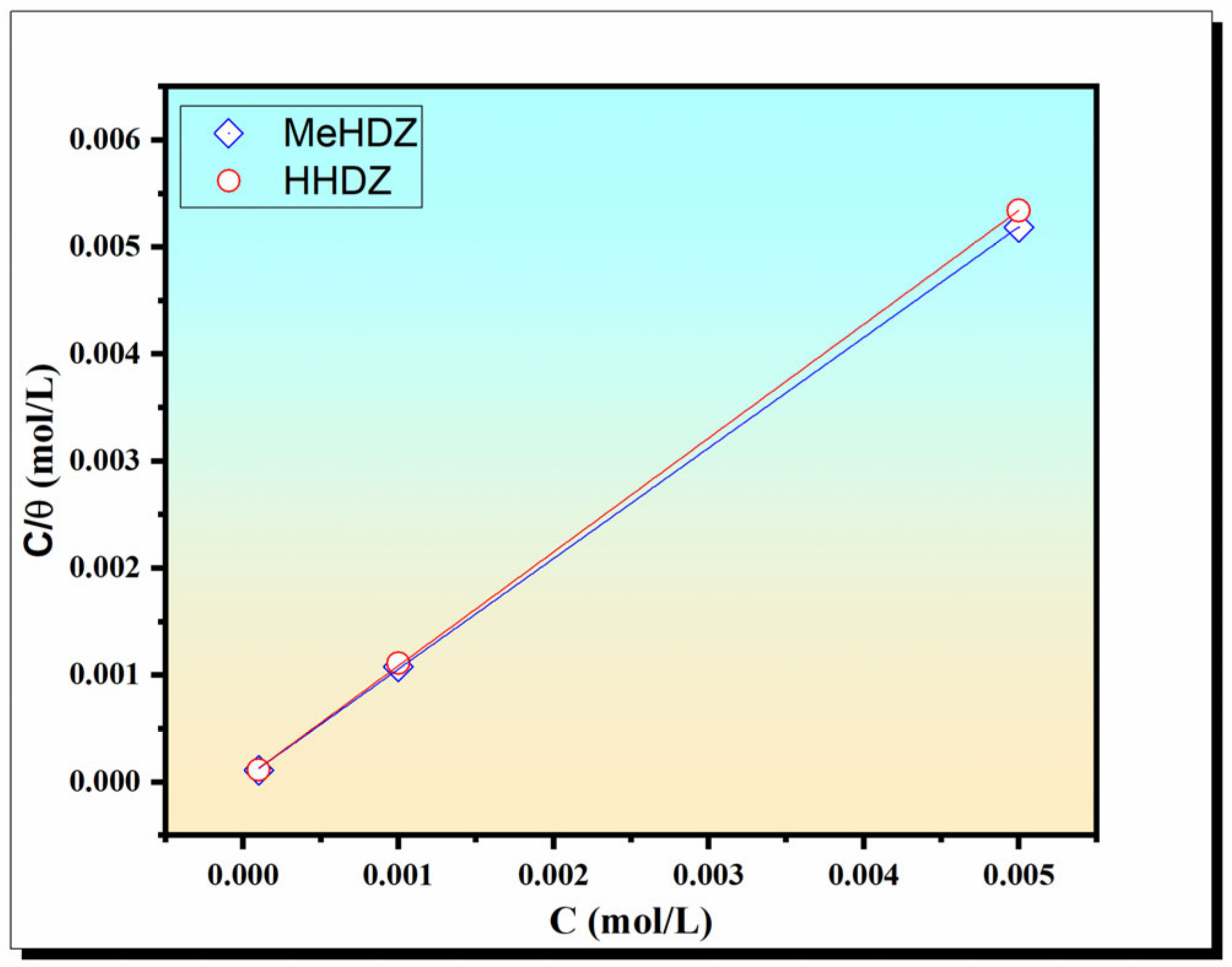
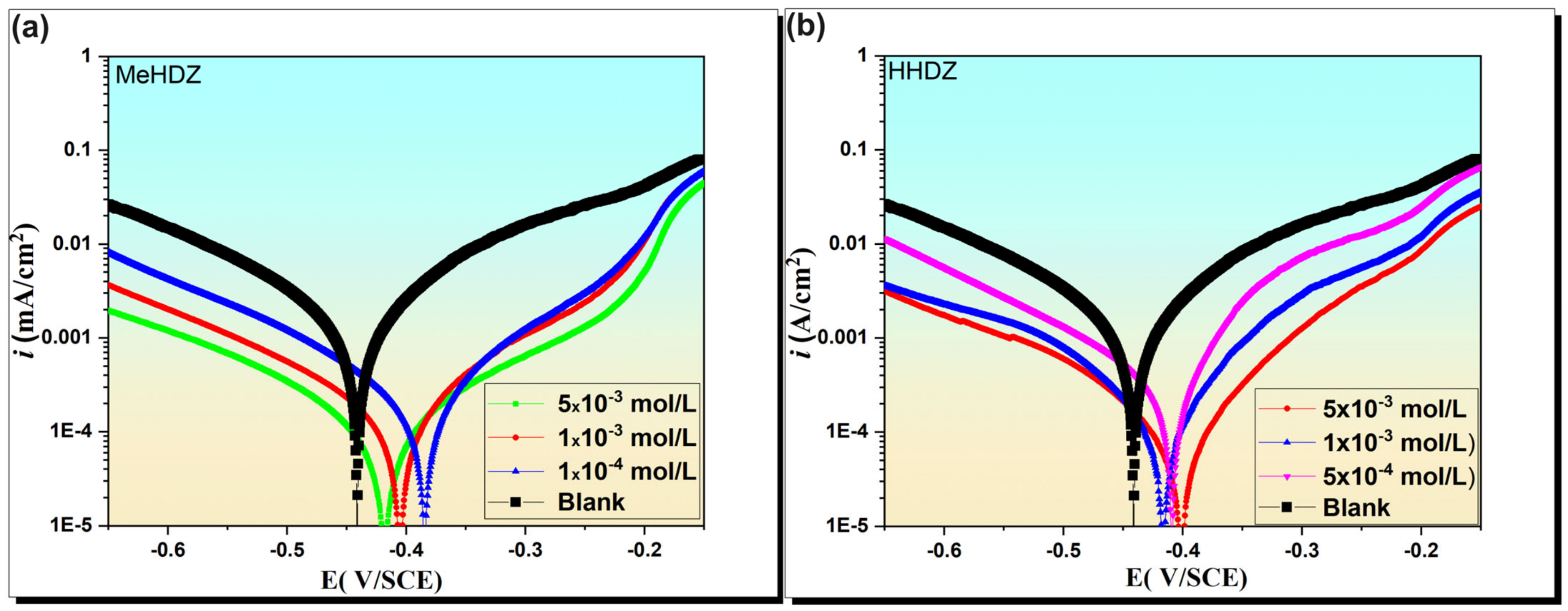
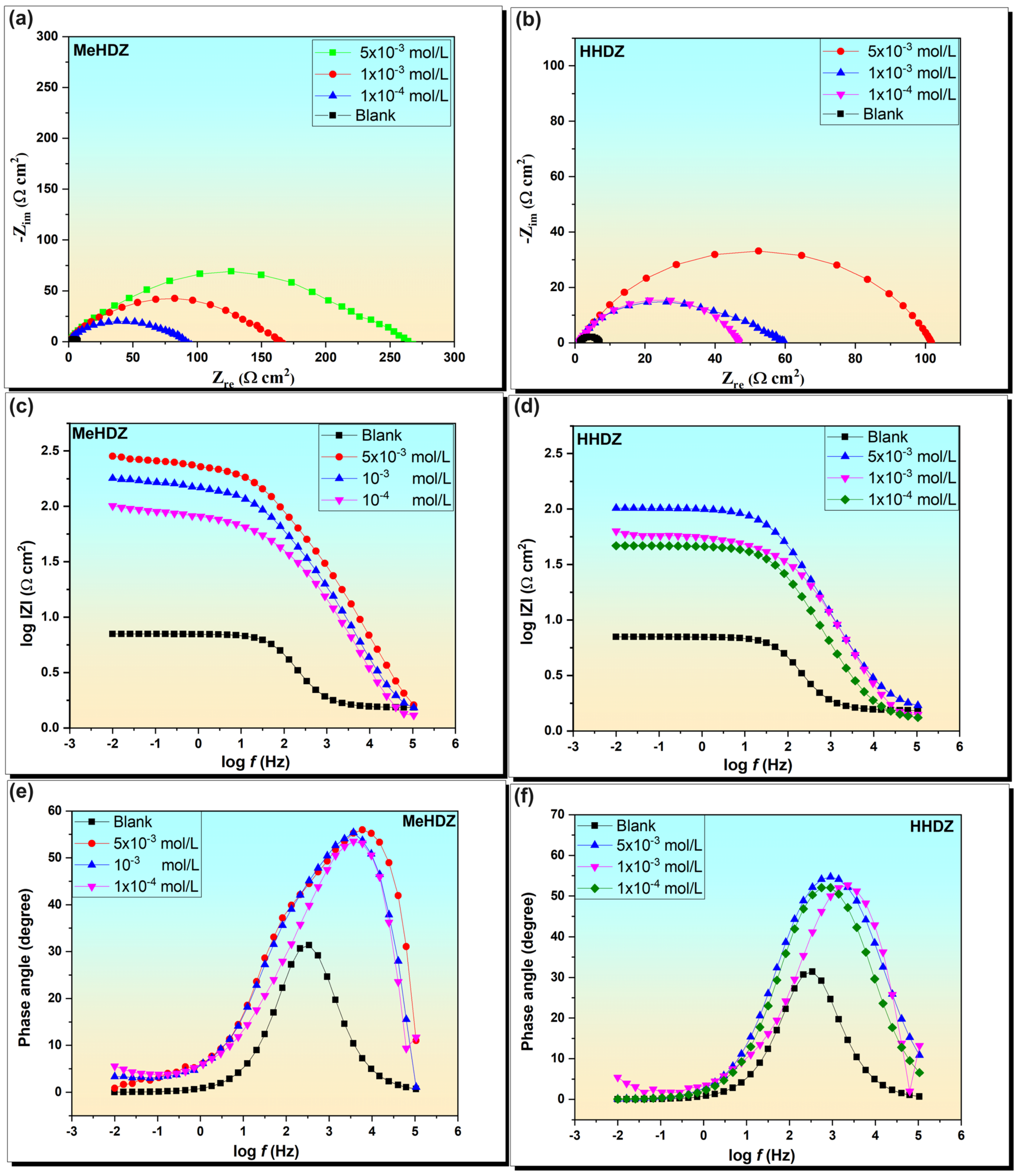
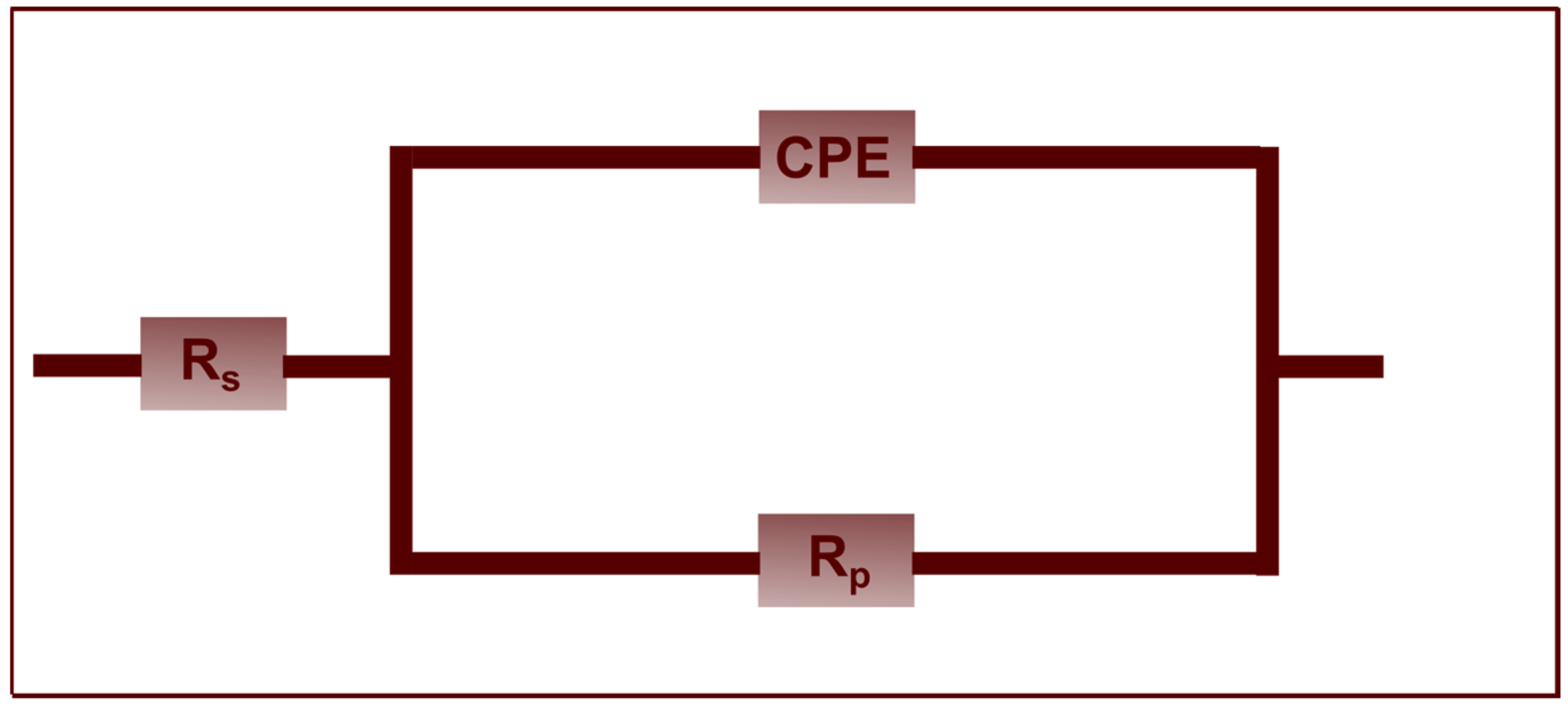

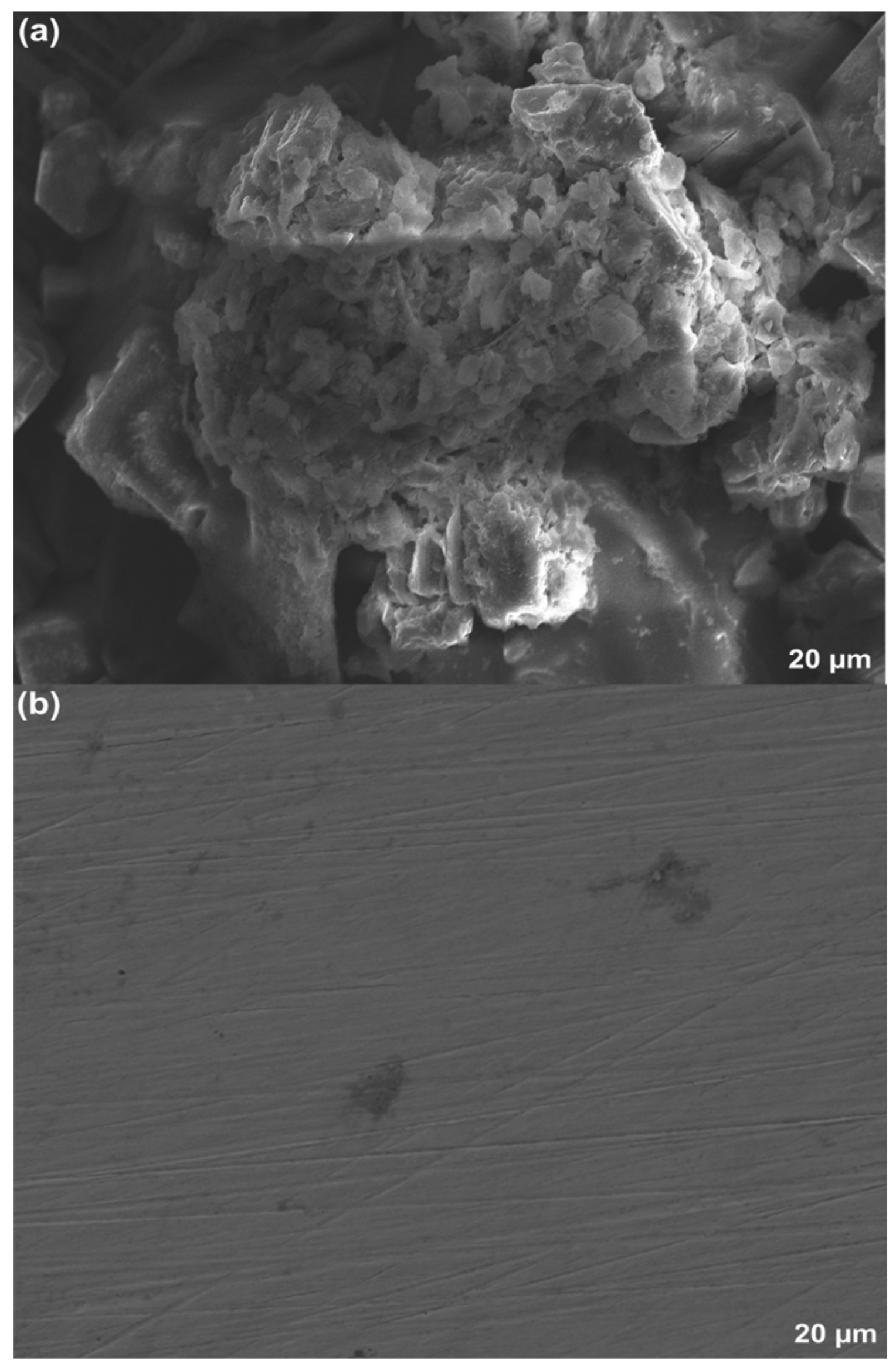
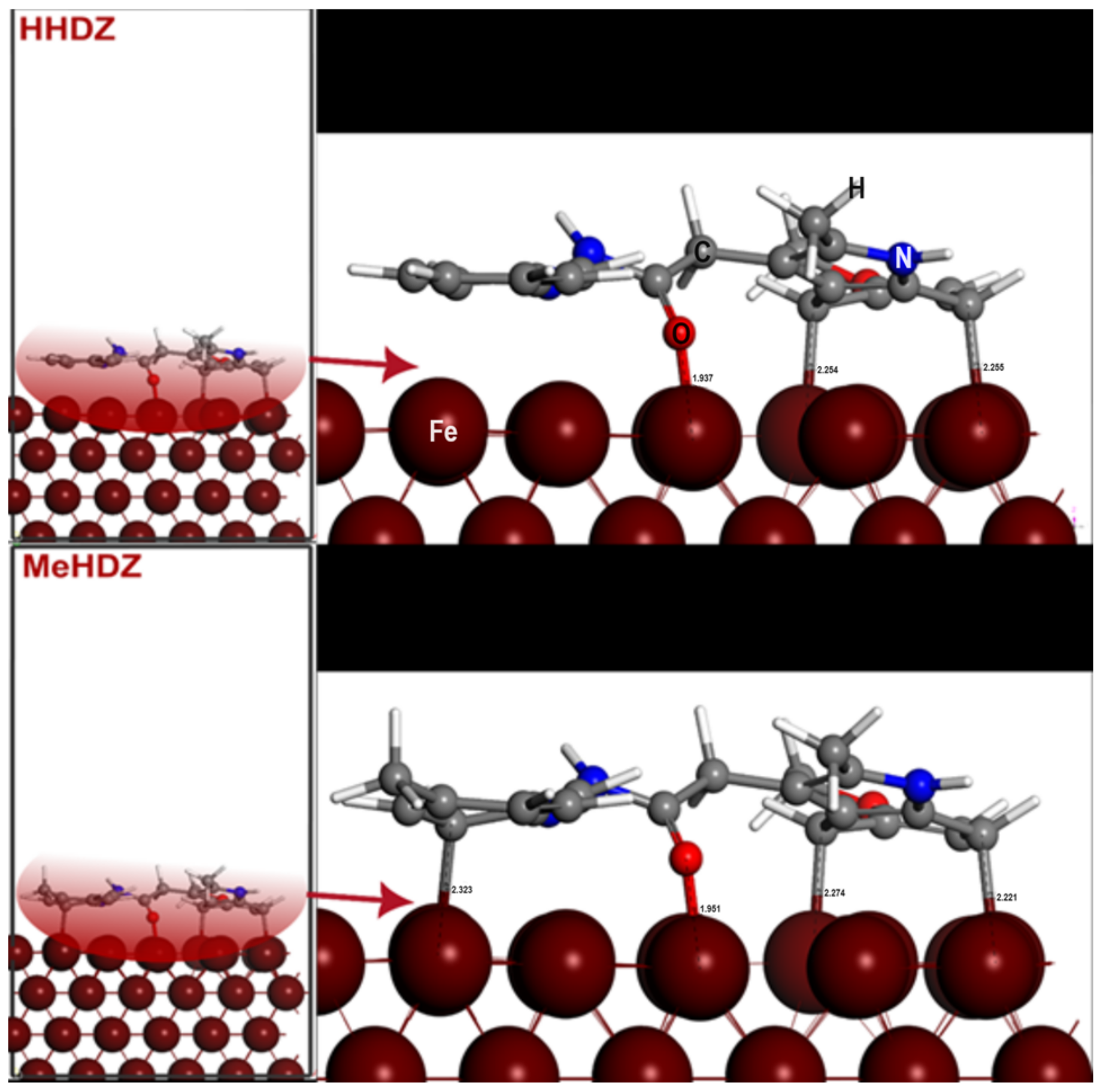

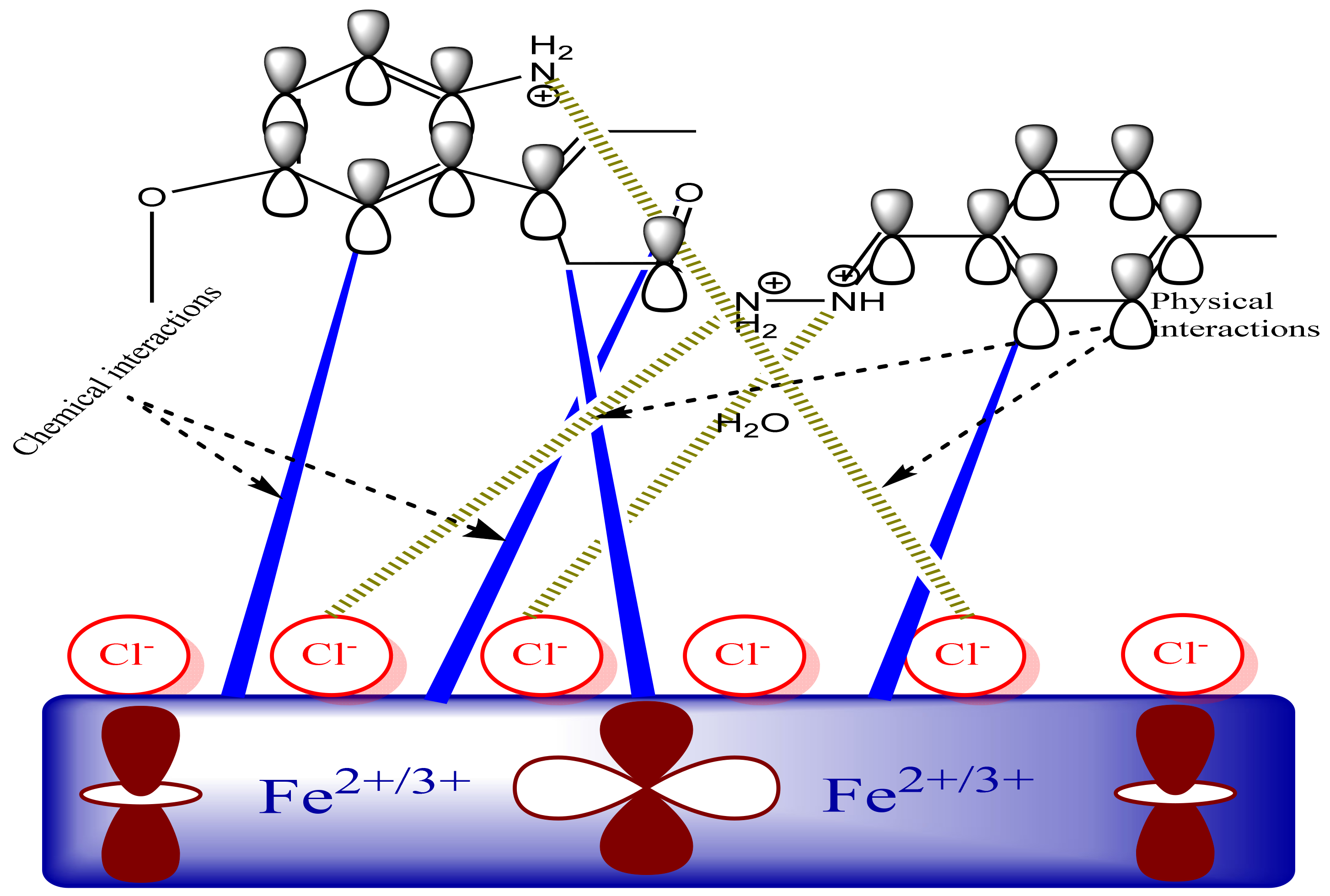
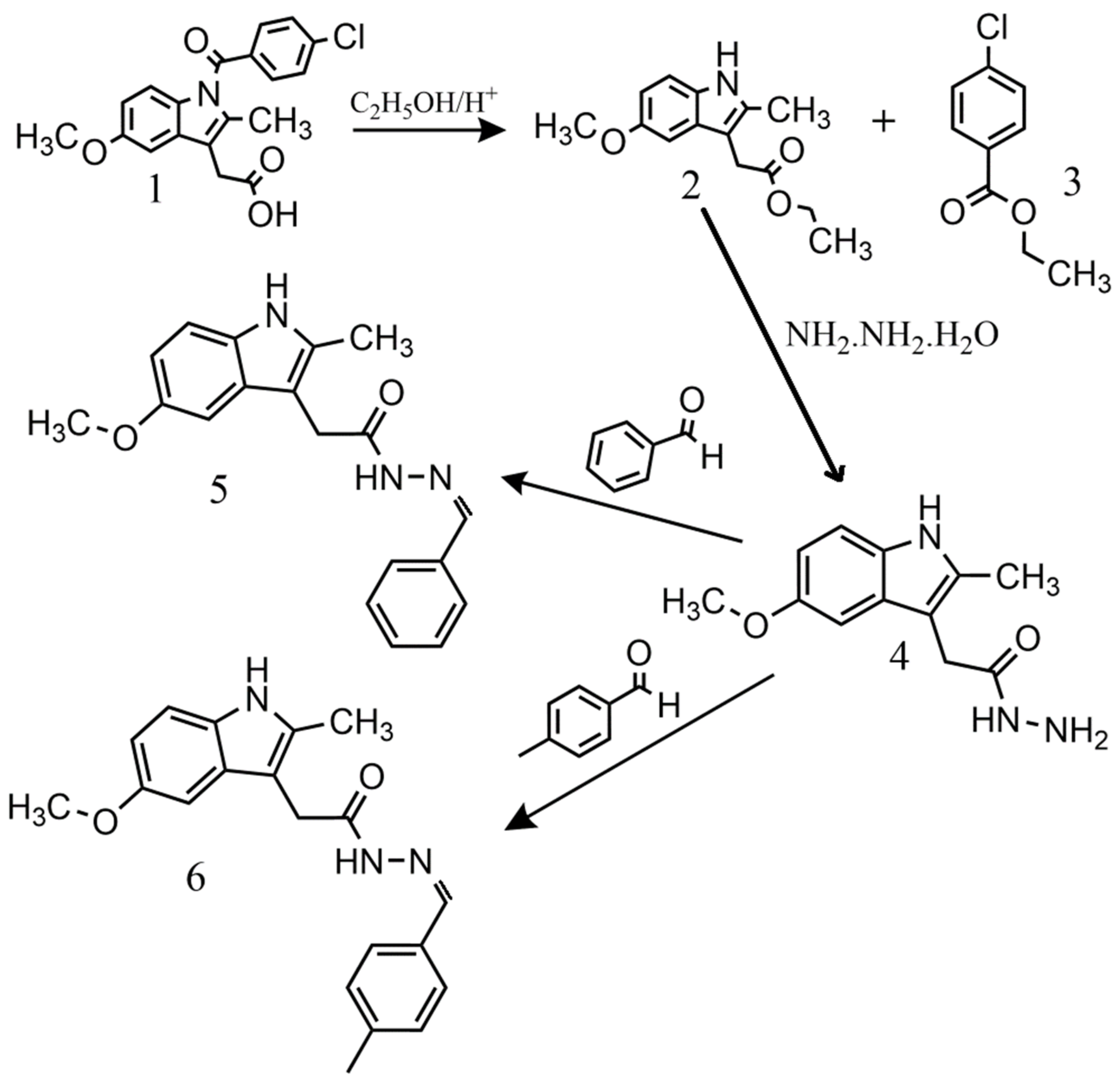
| [Inhibitor] (mol/L) | W (mm/year) | η (%) | ||
|---|---|---|---|---|
| 303 | 333 | 303 | 333 | |
| 15 wt.% HCl | 23.7 | 253.4 | - | - |
| MeHDZ | ||||
| 5 × 10−3 | 0.850 | 23.920 | 96.41 | 90.56 |
| 1 × 10−3 | 1.744 | 32.080 | 92.64 | 87.34 |
| 1 × 10−4 | 2.315 | 39.505 | 90.23 | 84.41 |
| HHDZ | ||||
| 5 × 10−3 | 1.509 | 31.218 | 93.63 | 87.68 |
| 1 × 10−3 | 2.355 | 39.631 | 90.06 | 84.36 |
| 1 × 10−4 | 2.744 | 45.966 | 88.42 | 81.86 |
| Inhibitor | Slope | (L/mol) | (KJ/mol) |
|---|---|---|---|
| MeHDZ | 1.05 | 39,985 | −36.79 |
| HHDZ | 1.02 | 40,706 | −36.83 |
| [Inhibitor] (mol/L) | icorr (µA/cm2) | −Ecorr (mV vs SCE) | βa (mV/dec) | −βc (mV/dec) | η (%) |
|---|---|---|---|---|---|
| 15% HCl | 1711 | 441 | 90 | 111 | - |
| MeHDZ | |||||
| 1 × 10−4 | 245 | 407 | 81 | 151 | 89 |
| 1 × 10−3 | 136 | 404 | 75 | 143 | 92 |
| 5 × 10−3 | 95 | 416 | 79 | 134 | 94 |
| HHDZ | |||||
| 1 × 10−4 | 243 | 408 | 77 | 150 | 86 |
| 1 × 10−3 | 168 | 416 | 74 | 147 | 90 |
| 5 × 10−3 | 118 | 400 | 78 | 139 | 93 |
| [Inhibitor] (mol/L) | Rs (Ω cm2) | Rp (Ω cm2) | CPE | Ceff,dl (µF/cm2) | η (%) | |
|---|---|---|---|---|---|---|
| Qdl (µF/cm2) | n | |||||
| 15% HCl | 1.5 | 5.51 | 697.8 | 0.837 | 236.2 | - |
| MeHDZ | ||||||
| 1 × 10−4 | 1.9 | 88 | 159 | 0.795 | 52.8 | 93 |
| 1 × 10−3 | 2.1 | 157 | 96 | 0.831 | 40.9 | 96 |
| 5 × 10−3 | 1.7 | 547 | 69 | 0.827 | 34.7 | 98 |
| HHDZ | ||||||
| 1 × 10−4 | 1.7 | 46 | 216 | 0.814 | 75.3 | 88 |
| 1 × 10−3 | 1.5 | 55 | 165 | 0.836 | 65.6 | 89 |
| 5 × 10−3 | 1.8 | 101 | 122 | 0.808 | 43.0 | 94 |
| Time (h) | Rs (Ω cm2) | Rp ) | n | Q (µF/cm2) | Ceff,dl (µF/cm2) |
|---|---|---|---|---|---|
| 0.5 | 1.7 | 547 | 0.827 | 69 | 34.7 |
| 3 | 1.1 | 479 | 0.836 | 71 | 43 |
| 6 | 2.1 | 515 | 0.817 | 68 | 44 |
| 12 | 2.4 | 544 | 0.813 | 73 | 49 |
| 24 | 1.6 | 576 | 0.849 | 72 | 49 |
| 30 | 2.1 | 560 | 0.801 | 67 | 41 |
Disclaimer/Publisher’s Note: The statements, opinions and data contained in all publications are solely those of the individual author(s) and contributor(s) and not of MDPI and/or the editor(s). MDPI and/or the editor(s) disclaim responsibility for any injury to people or property resulting from any ideas, methods, instructions or products referred to in the content. |
© 2024 by the authors. Licensee MDPI, Basel, Switzerland. This article is an open access article distributed under the terms and conditions of the Creative Commons Attribution (CC BY) license (https://creativecommons.org/licenses/by/4.0/).
Share and Cite
El-khlifi, A.; Zouhair, F.Z.; Al-Hadeethi, M.R.; Lgaz, H.; Lee, H.-s.; Salghi, R.; Hammouti, B.; Erramli, H. Assessment of Hydrazone Derivatives for Enhanced Steel Corrosion Resistance in 15 wt.% HCl Environments: A Dual Experimental and Theoretical Perspective. Molecules 2024, 29, 985. https://doi.org/10.3390/molecules29050985
El-khlifi A, Zouhair FZ, Al-Hadeethi MR, Lgaz H, Lee H-s, Salghi R, Hammouti B, Erramli H. Assessment of Hydrazone Derivatives for Enhanced Steel Corrosion Resistance in 15 wt.% HCl Environments: A Dual Experimental and Theoretical Perspective. Molecules. 2024; 29(5):985. https://doi.org/10.3390/molecules29050985
Chicago/Turabian StyleEl-khlifi, Abdelilah, Fatima Zahrae Zouhair, Mustafa R. Al-Hadeethi, Hassane Lgaz, Han-seung Lee, Rachid Salghi, Belkheir Hammouti, and Hamid Erramli. 2024. "Assessment of Hydrazone Derivatives for Enhanced Steel Corrosion Resistance in 15 wt.% HCl Environments: A Dual Experimental and Theoretical Perspective" Molecules 29, no. 5: 985. https://doi.org/10.3390/molecules29050985
APA StyleEl-khlifi, A., Zouhair, F. Z., Al-Hadeethi, M. R., Lgaz, H., Lee, H.-s., Salghi, R., Hammouti, B., & Erramli, H. (2024). Assessment of Hydrazone Derivatives for Enhanced Steel Corrosion Resistance in 15 wt.% HCl Environments: A Dual Experimental and Theoretical Perspective. Molecules, 29(5), 985. https://doi.org/10.3390/molecules29050985









